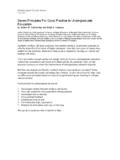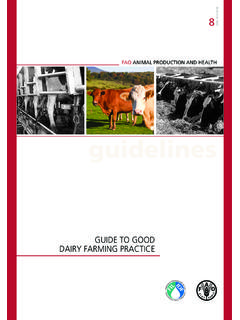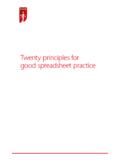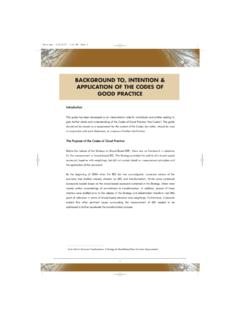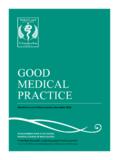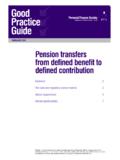Transcription of GUIDE TO GOOD PRACTICE IN CONTRACT …
1 GUIDE TO good PRACTICE IN CONTRACT labour IN FORESTRYGUIDE TO good PRACTICEIN CONTRACT LABOURIN FORESTRYR eport of the UNECE/FAO Team of Specialists on Best practices in Forest ContractingUNECE/FAO TEAM OF SPECIALISTS (TOS) ON BEST practices IN FOREST CONTRACTINGDr Edgar Kastenholz, Team Leader, European Network of Forest Entrepreneurs (ENFE), GermanyDr Czeslaw Dyduch, Polish Contractors Association, PolandMr Richard Fitzgerald, Foreign Agricultural Service, Forest and Rangeland, United States of America Mr Barrie Hudson, Hudson Consulting Ltd, United KingdomMr Simo Jaakkola, Trade Association of forestry Entrepreneurs, Koneyritt jien liitto ry, FinlandDr Ewa Lid n, DELO - Organisationsberatung, GermanyMr Kyriakos Monoyios, Department of Forests, Cyprus Mr Joachim Morat, Kuratorium f r Waldarbeit und Forsttechnik KWF, Frantisek Pasek, Ministry of Agriculture, forestry Section, Czech RepublicDr Michael Sachse, Saxonian Contractors Association (SFV), S chsischer Forstunternehmerverband, GermanyMr William Street, Builders and Woodworkers International (BWI)
2 , SwitzerlandMr Joachim Lorbach, Responsible Secretariat Member, Food and Agriculture Organization of the United Nations (FAO), Forest Products and Industries Team Food and Agriculture Organization of the United NationsRome, 2011 The designations employed and the presentation of material in this information product do not imply the expression of any opinion whatsoever on the part of the Food and Agriculture Organization of the United Nations (FAO) concerning the legal or development status of any country, territory, city or area or of its authorities, or concerning the delimitation of its frontiers or boundaries. The mention of specific companies or products of manufacturers, whether or not these have been patented, does not imply that these have been endorsed or recommended by FAO in preference to others of a similar nature that are not 978-92-5-106877-9 All rights reserved.
3 FAO encourages reproduction and dissemination of material in this information product. Non-commercial uses will be authorized free of charge, upon request. Reproduction for resale or other commercial purposes, including educational purposes, may incur fees. Applications for permission to reproduce or disseminate FAO copyright materials, and all queries concerning rights and licences, should be addressed by e-mail to or to the Chief, Publishing Policy and Support Branch, Office of Knowledge Exchange, Research and Extension, FAO, Viale delle Terme di Caracalla, 00153 Rome, Italy. FAO 2011 PrefaceiiiPREFACEOne aspect of the social pillar of sustainable forest management, which has so far received little attention at the policy level, is the forest workforce. There has been little recognition at the international level of the obvious fact that sustainable forestry requires a sustainable work force.
4 Increasingly, forestry operations, -notably harvesting- are carried out by contractors. These are often small or very small enterprises, which therefore face major challenges in terms of occupational safety and health and economic viability as they lack a strong structure of cooperation and mutual support. A team of specialists was set up under the integrated programme of the UNECE Timber Committee and the FAO European forestry Commission to address this issue. This team, led by Edgar Kastenholz of ENFE, has drawn up a GUIDE to good PRACTICE in CONTRACT labour in forestry , intended to help these contractors, and those working with them, to understand the issues, and function in a truly sustainable way. The GUIDE is based on European and North American conditions, but many of its suggestions are applicable elsewhere. We hope that this good PRACTICE GUIDE will take its place alongside other good PRACTICE guides prepared by FAO and its partners as a very practical contribution towards achieving sustainable forest take this opportunity to thank the team members for their work in opening up a new field of activity and drawing attention to a range of issues which need attention, but which, as this GUIDE shows, may also be solved by applying basic principles and learning from the experience of others.
5 The work was supported from the FAO staff side by Joachim Rojas-BrialesAssistant Director-GeneralForestry DepartmentContentsvCONTENTSPREFACE iiiCONTENTS vLIST OF EXAMPLES OF BEST PRACTICE viiSUMMARY viiiA model for good PRACTICE in CONTRACT labour in forestry viiiThe good forestry contractor should: viiiThe good client should .. ixThe legislator and public authorities should .. ixPART A: INTRODUCTION 1 Purpose of this GUIDE 1 Scope 1 Role of partners (Who) 2 Approach 2 Design and structure 2 PART B: ACTORS 3 The actors cooperation and integration 3 The target group forestry contractors 3 Employees and workers unions 4 Subcontractors 4 The clients of contractors forest owners and the timber industry 4 Public authorities / labour inspection 6 Certification and auditors 7 Influential bodies or pressure groups 8 Supporting organizations and help instruments 9 PART C. GUIDELINES FOR BEST practices 9 Human resources 11 Management skills 11 Staff development 13 Best practices 14 Social dialogue 18 Working conditions 20 Adequate wages/income 21 Safety and health 22 Job security 34 Best PRACTICE 35 Working time 36 Technology 39 Quality management 40 GUIDE to good PRACTICE in CONTRACT labour in forestryviEconomic viability 43 Competition 47 Cooperation 50 Organization 53 FUNDAMENTAL ILO CONVENTIONS 58 REFERENCES AND FURTHER READING 59 List of Examples of Best PracticeviiLIST OF EXAMPLES OF BEST PRACTICE1.
6 The relationship between a client and a contractor 52. Community relations and workers rights 73. Social criteria of the PEFC scheme 84. Guidelines and training for cost calculation 135. Training of forestry workers in Great Britain 156. Advanced training of machine operators 167. Certification of forestry workers in Ontario, Canada 178. Certificates of competence for forest machine operators 189. Machine operator employment CONTRACT in Finland 2310. Occupational safety management in Great Britain 2611. The need of training, even for professional loggers 2812. Handbook: Health and Performance in Mechanised Forest Operations 3013. Self-inspection of forest enterprises and contractors 3214. WORX make strengths and weaknesses in work conditions visible 3315. Federal tariff agreement for employees of member associations of the German forestry contractors association (Deutscher Forstunternehmer-Verband DFUV) 3616.
7 Measures to reduce long working hours on machines 3817. Assessment of work-shift rosters 3918. Ergonomic guidelines for forestry machines 4119. Quality management 4420. forestry contractors as a driving force for innovation and a crucial resource for sustainable forest management 4721. Erkenningsregeling Bosaannemers 4922. Certification as facilitator for fair competition Finland 5023. The Business Approach to improve harvesting services in Sweden 5224. A set of examples for cooperation from Finland 5325. The European Network of Forest Entrepreneurs (ENFE) 56 GUIDE to good PRACTICE in CONTRACT labour in forestrySUMMARY A MODEL FOR good PRACTICE IN CONTRACT labour IN forestry This GUIDE illustrates how good PRACTICE in CONTRACT labour in forestry can be implemented. A number of examples of tools, instruments and strategies are presented. References and contact details to obtain further information complement these guidelines.
8 The following model is a summary of the various criteria for good PRACTICE that make up the content of this GUIDE . It does not simply explain what the working conditions should be. Instead, it outlines framework conditions contributing to a good business environment thereby allowing fair competition and partnerships between forestry contractors and their clients as well as among contractors good forestry contractor should:.. be registered as a business with the competent national or regional authority according to the regulations in force. These are based on rules recognized by the entire sector and that lay down the criteria for the registration of a business with the public authorities; .. have a competent and qualified business management that not only has the ability to take operational decisions but also to conduct a business in an entrepreneurial way.
9 In order to do this the business management has management staff with accounting skills as well as expert knowledge of investment planning and assessment of offers; .. employ qualified staff. All employees are qualified for the tasks assigned to them. Anyone taking on new duties without adequate experience is extensively instructed and trained before starting work. Staff skills should always be up to date through further training. Employees need to be informed about and to be involved in business decisions, particularly when their own working conditions depend upon any changes in procedures and work organization;.. possess adequate, well maintained equipment that ensures operations are carried out as safely as possible and to a high standard of excellence;.. have sufficient provision of capital to be able to recruit and employ qualified staff on a long-term basis and to afford investments in necessary technology in spite of a fluctuating volume of orders.
10 Attain and maintain a quality management system to continually improve structures and processes. The management system documents and provides evidence that the quality of business management and performance is approved by an external supervision that is in accordance with clear standards recognized by the entire sector. Because of the quality management system the business increases in competitiveness, compared with uncertified contractors, as clients give preference to businesses possessing quality supervision;.. regulate health and safety at work within an occupational safety management system that clearly describes and documents structures and processes of cooperation with other contractors and with subcontractors. All employees of the business should participate in its implementation; .. conclude long-term labour contracts with his employees, in which working conditions and payment of a socially adequate kind and amount are laid down in a juridical way.












